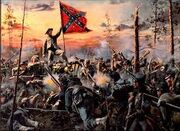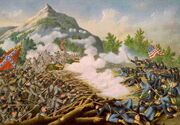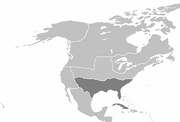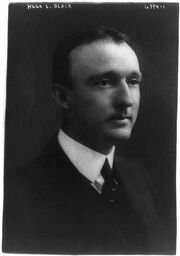| |||||||
| Anthem | "The Bonnie Blue Flag" | ||||||
| Capital | Richmond, Virginia | ||||||
| Largest city | Houston | ||||||
| Other cities | Atlanta, Dallas, New Orleans | ||||||
| Language | English | ||||||
| Religion main |
Protestantism | ||||||
| others | Roman Catholicism | ||||||
| Demonym | Confederate | ||||||
| Established | August 15, 1858 | ||||||
| Independence | from United States | ||||||
| Annexation | to United States | ||||||
| date | Began: 1945
Finished: 2012 | ||||||
| Currency | Confederate dollar | ||||||
History[]
War of Independence[]

Confederate War of Independence
Arguments over slavery, state's rights, and the fact that the South possessed an entirely different culture from the North resulted in the secession of southern states from the United States in 1858, two years following the presidential election of John C. Fremont of the antislavery Republican party. Led by Jefferson Davis, thousands of southerners joined the army, and the Confederate bombardment of Fort Sumter in 1858 led to the Confederate War of Independence's beginning. Despite initial Union advances and the fact they had more manpower and industry, southern generals turned the war around. Heroes like Robert E. Lee and "Stonewall" Jackson held back the Union advance and inspired their soldiers. The south had better soldiers and believed in defending their way of life, but on the downside it had to import most of its supplies and equipment, resulting in a Union blockade. Victories during a major invasion of the north during 1860 convinced major Union enemies California and Canada, French satilite empire of Mexico)and by extension the United Kingdom(inspired by supporters of the{ {wiki:treadmill}} to enter the war on the side of the Confederacy. Britain's Royal Navy ended the Union blockade, allowing fresh supplies to flow into the south. Union advances in the west were defeated, and the south threatened Washington D.C. Faced with defeat, Fremont was forced to call for a ceasefire and grant the Confederate states independence.
New Nation[]
The new nation, now finally free, had to deal with rebuilding the war-torn northern states that had campaigned on for four years. Confederate leaders had also learned the importance of railroads, telegrams, mines, and factories that had nearly propelled the Union into victory. With the aid of Great Britain, the infrastructure was of the south was rebuilt in the north and improved upon in the south. New railroads such as ones connecting Richmond to Atlanta and Columbia, as well as new telegram lines, connecting the nation together. However, the states were in charge of these operations, and not the government. In exchange for the help from Britain, a reluctant new president Alexander H. Stephens freed the slaves of the south. Even though they had been freed, equality would not be present for the blacks for a long time because separate was NOT equal.

Confederates soldiers holding off a Union advance during the War of 1885
In 1874, Confederate president agreed to a deal with Californian prime minister John McDougall to create a Transcontinental Railroad between the two nations, much to the chagrin of the north. Fueled by cheap(no unions-get it???)black labor, the railway was completed in 1881. Goods could easily pass through the two nations, powering the economy. New factories, mines, schools, and railways were built. In 1885, the United States and the Confederacy would once again go to war. The Confederates would defeat the initial American invasion and turned the war around, driving toward Washington. Although the Confederate advance was defeated at Annapolis, the Union was forced to sue for peace. Another Confederate victory ensured that the Confederacy was forever free and the north could not hope to retake it.
Progressive Era and World War I[]

Confederate States, 1890
Even though it experienced slow population growth and immigration between the War of 1885 and World War I, the industrialization the south experienced was on the backs of uneducated white workers, women and children, and blacks. Populations shifted to cities, where many found employment in new the factories and textile mills, to produce rifles, rails, and equipment for farming. Cities like Birmingham, Dallas and Atlanta experienced huge population booms. The oil business in Texas, Arkansas, and in the Gulf of Mexico led to economic expansion. Workers rights' were not existent, as bosses could easily place an angry worker with hundreds waiting for jobs, while state governments were hostile to industry and business.
Wealthy plantation owners dominated Confederate politics, with many refusing to redistrict to show that populations have switched to cities. Sharecropping and tenant farming were widespread across the south. This led to a cycle of poverty among lower class farmers, and were unable to move up in life and lived in deplorable living conditions. The NFA and FFA and Juan Crow Vaquaroes movements attempting to raise concern for these problems were destroyed by the plantation owners, who responded with violence and fear tactics.
President Woodrow Wilson became the president in 1911 and increased segrgation in the Capital, when the First World War engulfed the world. The turmoil in the Balkans had lead to a much larger war between the nations of the world. The Confederacy, part of the London Pact, was swept up in the chain of alliances and war was declared on the United States. The rest of North America would soon be drawn into the war as well. A Confederate offensive

Confederate soldiers in trenches in Kentucky, 1914
toward Washington D.C. and Philadelphia was stalled and pushed back, and the war soon bogged down in trench warfare as thousands of young men were killed or wounded. However, the northern industry adapted to the war, and produced more industry than the south could. By 1915, the Confederacy were outgunned and far behind in industry. American offensives began in the summer of 1915 and continued into 1917, when Union armies marched into Richmond, Virginia after capturing Tennessee and parts of Mississippi. This forced Wilson to sue for peace in 1917, ending World War I in defeat. For the first time the Confederates had lost to the Union.
Dark Times[]
With the London Pact's victory in Europe, and no desire to cross an ocean to help the south (having abolished the Treadmill) the Confederacy was left to their own devices. The Treaty of Portsmouth forced the Confederacy to hand over Oklahoma to the Union, demilitarize Tennessee and Virginia, and pay heavy war reparations. Southerners were quick to blame the former slaves and who were unqualified and gained their position due to their family members and friends. Newly elected president Nathan Forrest 2 inherited a difficult situation; hyperinflation and massive debt caused terrible economic crises. attempted to hide the problems with loans and tariffs, as well as promoting the new movie and radio industry, which were capable of united a nation together.Triumph Of The Confederate Will, a film released in 1924, created a new sense of nationalism in the nation, despite the unemployment and debt the nation faced.

Hugo Black became the dictator of the Confederacy in the Great Depression
There were still individuals that proposed radical ways to return the nation to prosperity, the most important being Hugo Black, a war veteran and leader of the "Army of Virginia" Party, which believed in National Socialism. The Army of Virginia promised to remove the old leaders from their positions of power and replaced them with his own, industrialize the nation, and get revenge on the north. However, his ideas would be ignored, especially after two gunmen affiliated with Natsoc gunned down President Henry L. Whitfield in 1928. For this, Black was thrown in prison, though he would released ten months later.
The Stock Market Crash and Great Depression took the nation by storm, sending thousands out of work and destroying the already ruined economy. Black had rebuilt the Natsoc Party, and the Depression gave him the support he needed. In 1936, Black defeated Dennis Murphee in the election and became president. Black immediately set to work; sending opponents to prison camps out west, appointing his allies for important offices, systematically removing the little rights the lower middle classes had, and silencing free speech and free press. Black also blamed Britain and Germany for their "great betrayal" following the end of World War I, and instead allied with the fascist France/Mexico> France, Italy, Japan, and the Confederacy would form the Axis Powers in 1939.
Appeasement and World War II[]
Black became bolder; he re-armed and resupplied and expanded the army, and built new fighters, ships and subs, and re-militarized the northern border, which was outlawed by the Treaty of Versailles. He demanded that the Union give the Confederacy Oklahoma back; hoping to appease the Confederate government, Union President Samuel Aaron DeWitt let the state have a vote. The citizens of Oklahoma overwhelmingly agreed, and the two states were returned to the Confederacy, with Black promising not the re-militarize them. However, he would break his promise and sent divisions of soldiers, tanks, and planes to the states. The Confederacy had turned itself around, shrugged off the depression, and was strong and powerful. Black was convinced it was time to get vengeance on the United States.

Confederate paratroopers during the invasion of Kentucky
World War II began in 1940 in Europe. North America would remain quiet until in the summer of 1941 the Confederacy launched their massive invasion of the United States. The Confederates aimed to strike fast and take the major population centers of the east, along with western industrial areas like Pittsburgh and Kentucky. The final War Between the States was a ferocious one, as US President Franklin Roosevelt rallied the nation,(except for Americans of Japanese decent) and the Confederate offensive was stopped at both Pittsburgh and the famous Battle of Washington. The Confederate destruction of the White House would be known as the High Water Point of the Confederacy, as after that it was all defeats.
The Confederate struggled to replace their lost manpower and equipment, while the US launched a counteroffensive into the south. US General George Patton led the devastating March to the Sea campaign in 1944, killing thousands and burning much of the states of Alabama, Mississippi, and Georgia to the ground. Marshall's army converged with George Patton's army in the Battle of Atlanta. While the war raged above, president Hugo Black committed suicide in his underground bunker, allowing General Holland Smith to surrender and end the war.
American campaigns in Texas had discovered the horrific ethnic cleansing that Black had ordered. Blacks were rounded up and shipped to concentration and death camps in attempt to rid the entire south of its black population. This genocide would be a major stain on the legacy of the Confederacys fallen troops.
In the aftermath, it was decided that the Confederacy was to be dissolved forever. The Alabama Pact would last decades and undergo several rebellions until all the states were re-incorporated in late 1990.



